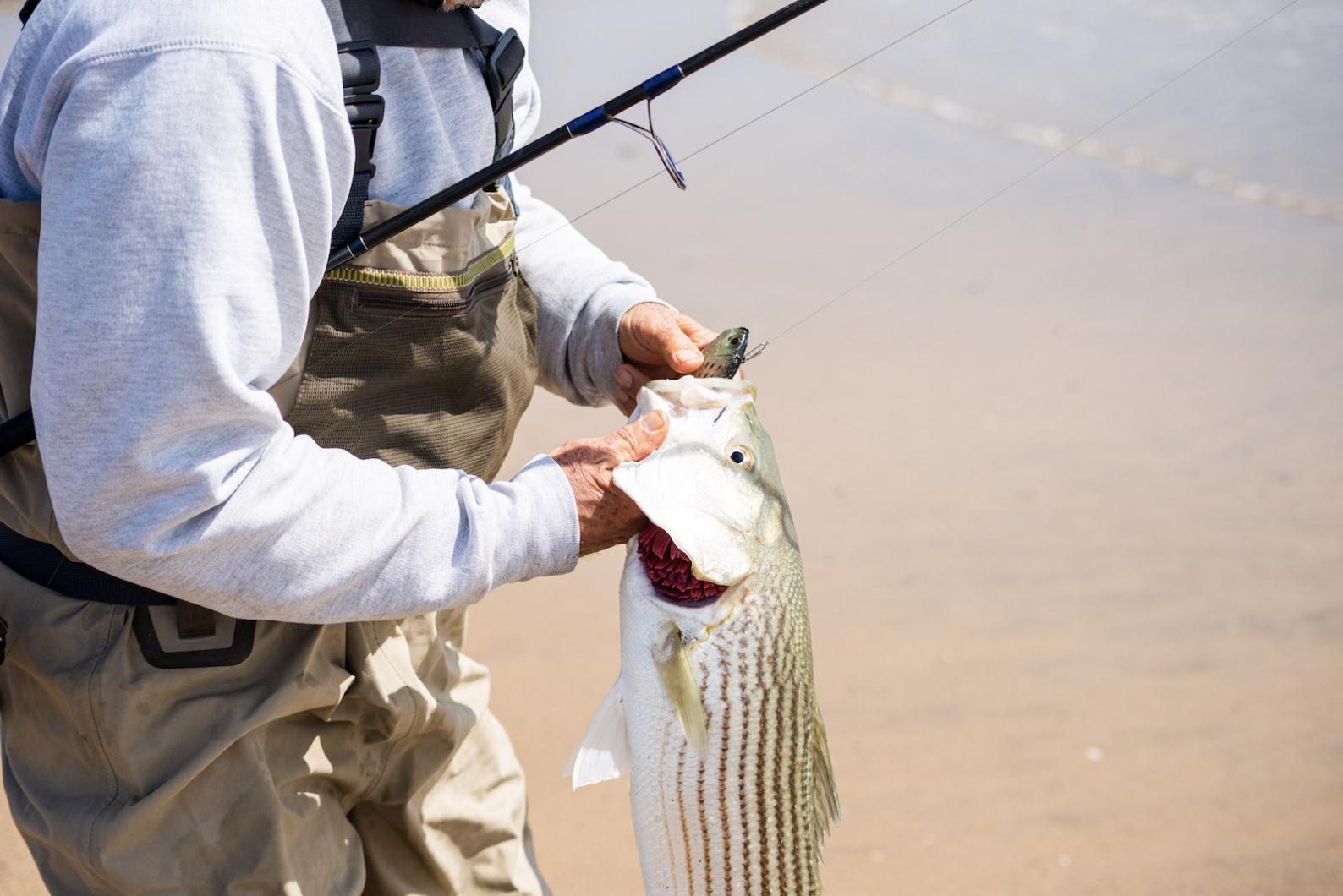After climbing back from the brink of extinction decades ago, the striped bass fishery is again in jeopardy, prompting interstate fishery regulators to take emergency action last week.
In an effort to protect one of the last large classes of fish now reaching breeding age, the Atlantic States Marine Fisheries Commission dropped the recreational maximum keeper size limit for a striped bass from 35 inches to 31. The measure affects the entire east coast and leaves only a narrow window for recreational anglers to keep their catch.
Officials say the move is in response to an unprecedented recreational harvest in 2022 that was nearly double the size of 2021. States must come into compliance with the new measure, which allows recreational fishermen to keep stripers between 28 inches and 31 inches, by July 2.
The new regulation was encouraged by Vineyard fishermen and guides who wanted to ramp up conservation efforts to preserve striped bass, a fish that had rebounded after a 1985 moratorium.
“Unfortunately, we have not done a great job since that rebound in the ‘80s,” said Edgartown-based fishing guide Brice Contessa, who spoke strongly in favor of the regulation. “We put our feet on the gas pedal too fast.”
Mr. Contessa is a member of the American Saltwater Guides Association, one of the groups lobbying for the action. He called the emergency action a “stop-gap,” ensuring immediate protection before a more comprehensive fishery assessment is done for the 2024 season.
Vineyard anglers have long been active in striper regulation. In 1985, before the state moratorium, the Striped Bass and Bluefish Derby removed stripers from the competition, a contentious decision that led to the withdrawal of several sponsors. The species returned to the derby in 1993, but in 2020 the derby committee voted to take them out again and they have yet to return.
“The derby has always placed trust in fisheries scientists and biologists,” longtime derby president John Custer wrote in a statement to the Gazette. “While we acknowledge that not including striped bass in the derby is disappointing to many, we also know it is really the only prudent approach at this time.”
Island anglers spoke largely in favor of the emergency action, but some felt that the regulations are too little, too late.
“It’s a step in the right direction, I just wish they would’ve jumped instead of stepped,” said Cooper Gilkes 3rd, owner of Coop’s Bait and Tackle. “We had them back, and we lost them again.”
Mr. Gilkes spoke in favor of instituting another moratorium, pointing out that commercial striper regulations were as yet unchanged by the emergency action.
“Why not just shut it down, get the fish back, and stop playing around?” he asked. “We just can’t seem to get it done.”
Longtime striper fisherman Ron Domurat was similarly critical of the commission’s approach to management. Following the species recovery from the crash in the 1980s, he said, the commission loosened their regulations, coinciding with a huge boom in recreational fishing. It is that recreational fishery, rather than the commercial, that Mr. Domurat sees as the main culprit.
“There were warning signs 12 years ago, and the [ASMFC] just kind of pushed it off,” he said.
In 2021, 1.82 million fish were harvested recreationally. The recreational catch-and-release fishermen have a 9 per cent mortality rate, adding 2.6 million dead stripers in 2021, according to ASMFC.
The total commercial harvest in 2021 came to about 634,000 fish.
Peter Sliwkowski, owner of Larry’s Bait and Tackle, expressed some skepticism about that 9 per cent figure, and noted that harvest numbers don’t tell the whole story for fishery management.
He pointed out that commercial fishermen in Massachusetts can only harvest fish over 35 inches. Allowing them to bring in those larger, breeding-age fish, Mr. Sliwkowski said, might undermine the intent of the emergency regulation.
Mr. Contessa agreed.
“If the idea is to protect the adult breeding fish, it doesn’t make a lot of sense,” he said. Mr. Contessa did express optimism that it would be corrected when the stock is reassessed.
Abby Schuster, a local fly-fishing guide and a member of the American Saltwater Guides Association, also spoke optimistically about the new regulations.
“Recreational fishing is growing so fast and so much, so I think it’s great that that is where the focus is,” she said.
Ms. Schuster encouraged recreational anglers to take steps to limit mortality in their catch. She recommended keeping fish in the water as much as possible, and keeping them in a net for a few minutes before release, giving them a chance to recover the ability to avoid predators.
The current goal for the ASMFC is to bring about a recovery of the striper stock by 2029. With these new emergency regulations, the commission gives such a recovery a 50 per cent chance of success.
For Mr. Gilkes, without more stringent regulations, the recovery seems unlikely. “Really, I feel sorry for the kids growing up now that won’t have a chance to catch that,” he said, pointing to a 53-pound striper mounted on his wall. “It’s a heck of an experience to catch something like that.”






Comments (20)
Comments
Comment policy »